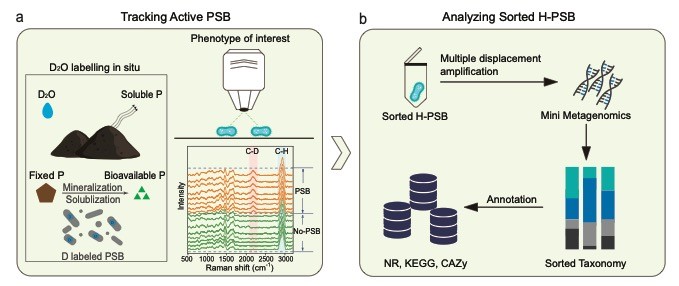Phosphorus availability is a critical factor limiting agricultural productivity worldwide. However, a large portion of phosphorus in soils exists in fixed forms unavailable to plants. Phosphate-solubilizing bacteria (PSB) play a crucial role in mobilizing this fixed phosphorus, but identifying and quantifying metabolically active PSB in complex soils has remained challenging.
In a study published in Nature Food, a research team led by Prof. Yong-Guan Zhu and Prof. Li Cui from the Institute of Urban Environment and Research Center for Eco-Environmental Sciences, Chinese Academy of Sciences, developed a novel single-cell approach to explore active PSB across diverse soil types.
"Understanding the in-situ activity of PSB is fundamental for guiding efficient fertilizer application and sustainable phosphorus management," said Prof. Zhu. "However, traditional bulk techniques struggle to resolve the specific activities of individual microorganisms in soils."
The researchers employed single-cell Raman spectroscopy combined with heavy water labeling to discern and quantify active indigenous PSB in soils in a culture-independent way. They optimized the method to work across different soil types and fertilization regimes.
Using this approach, the abundance and phosphorus solubilizing efficiency of active PSB were quantified in nine soil samples. A clear influence of soil properties and fertilization practices on PSB activity was revealed.
"Our single-cell phenotypic characterization provides direct insight into the in-situ phosphorus solubilization abilities of soil microbes, overcoming limitations of genome-centric methods," said Prof. Cui.
The most active PSB were further isolated by single cell sorting for targeted metagenomic sequencing. This allowed the researchers to link phosphorus solubilizing phenotypes to specific bacterial taxa and genetic determinants. Several previously unrecognized genera exhibiting high phosphorus solubilization capability were identified. The underlying phosphorus and carbon cycling genes involved in phosphorus mobilization were also elucidated.
"Discovery of these novel, highly active PSB in soils provides promising microbial resources for developing advanced biofertilizers," said Prof. Zhu.
This work advances the understanding of active PSB within their native soil habitats. The developed single-cell approach linking phenotypes to genomes offers a powerful tool for exploring beneficial soil microbes to enhance agricultural sustainability.

Single-cell Raman-D2O approach for identifying active PSB in soils and linking their phenotypes to genotypes through targeted sorting and sequencing
Contact: CUI Li
E-mail: lcui@iue.ac.cn
Link:https://doi.org/10.1038/s43016-024-01024-8